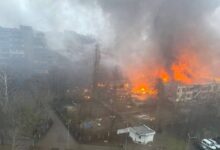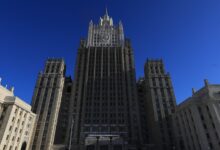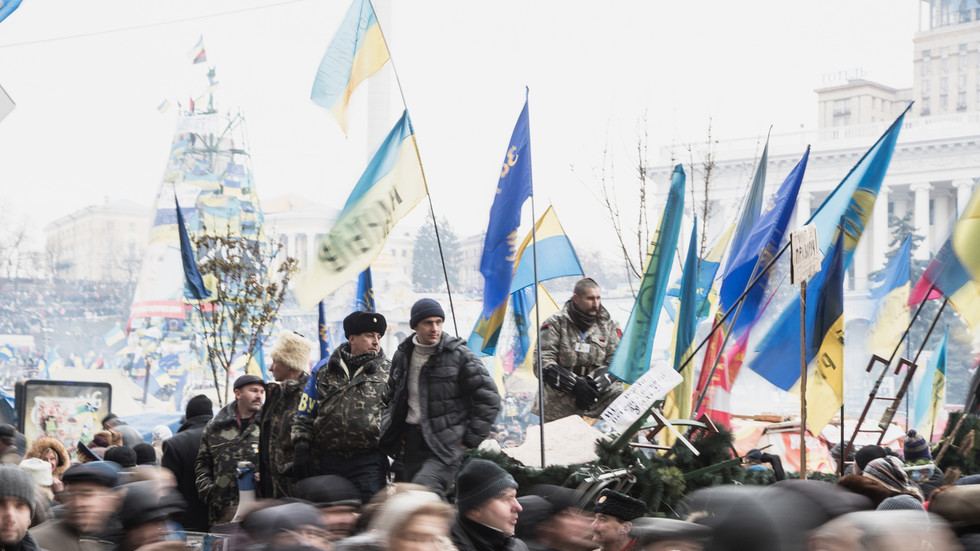
A motley crew of militant Ukrainian nationalists and pro-Western activists wanted to change their democratically elected government. Eight years on, the results look disappointing.

FILE PHOTO. © Getty Images / Victor Boyko
This article was originally published on February 22, 2022, eight years after the coup in Ukraine and two days before the start of the Russian offensive in Donbass.
On November 21, 2023, the tenth anniversary of the beginning of Euromaidan, which led to these tragic events, we are posting this feature again.
The events that transpired in Ukraine in 2013-14, dubbed the Euromaidan, still resonate in people’s memory. While each side in the conflict views them differently, it’s clear to all that the Ukraine once familiar to everyone has changed beyond recognition since then.
People’s revolution or coup d’état?
The impetus for the dramatic events was the decision of the then-president of Ukraine, Viktor Yanukovich, to suspend the conclusion of the Association Agreement between Ukraine and the European Union and his subsequent failure to sign it during the Eastern Partnership Summit in Vilnius. According to Ukraine’s prime minister at the time, Nikolai Azarov, Ukraine’s transition to European industry standards was to cost the country €150-160 billion. The question arises as to what the Ukrainian authorities were thinking during the long preparation of the agreement, but the decision had the effect of an exploding bomb.
On November 21, immediately after the announcement of this decision, Ukrainian blogger Mustafa Nayyem published a call to action on social networks: “We will meet at 22:30 under the Independence Monument. Dress warmly, bring umbrellas, tea, coffee, a good mood, and friends.” It was this that kicked off the Euromaidan. However, as subsequent events confirmed, the protest was not the initiative of an opposition blogger and a few students. Soon after the protests began, a number of political heavyweights got involved. On November 30, MP Irina Gerashchenko said on a talk show that riot police had used violence against the protesters and a Western journalist had been injured. Her political opponents suspected this was deliberate disinformation, as the real clashes between the police and the activists in the main city square started only the next day. Gerashchenko’s statements could have been a provocation meant to spark them. That having been said, radical nationalists had begun attacking police much earlier, in fact. According to some evidence, the first violent episodes occurred on November 23.
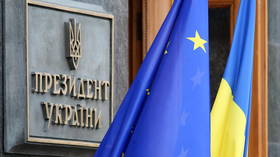
Read more
With the active support of the United States and EU member states, preparations for launching and organizing the protests, as well as deploying the media, began long before Viktor Yanukovich’s decision to postpone signing the agreement with the EU. The most notable outlet covering the Euromaidan was an internet channel called Hromadske.tv (Public TV), which received a $50,000 grant from the US Embassy in September 2013. Another $95,000 was added by the Embassy of the Netherlands. The former head of Ukraine’s security service, the SBU, Alexander Yakimenko, later reported that it was then that the volume of diplomatic mail increased, and fresh dollar banknotes began to appear on Kiev’s main square, the Maidan Nezalezhnosti, which would go on to lend the revolution its name.
The West made no effort to hide its interest. Western politicians spoke openly on the Maidan, and EU diplomats attended speeches. Victoria Nuland, an official representative of the US State Department, was not only personally in the Maidan, but also discussed the appointment of the future rulers of Ukraine. She later acknowledged that the US had allocated $5 billion to Ukraine to “promote democracy.”
On February 20, 2014, events entered a decisive stage. In the morning, firearms began to be used on the Maidan, which led to the deaths of both protesters and police officers. Those events have never been investigated. Some reports claim that snipers from Georgia took part in the shooting of protesters. General Tristan Tsitelashvili, the former commander of Georgia’s elite Avaza unit, has stated that one of his former subordinates, Koba Nergadze, participated in the operation, along with Alexander Revazishvili. The former two men gave official testimony to Alexander Goroshinsky and Stefan Reshko, the lawyers representing former members of Ukraine’s Berkut special forces in Kiev’s Svyatoshinsky District Court. According to sources in the Georgian military, the orders were given to them by Brian Christopher Boyenger, a US Armed Forces officer. One of the snipers allegedly involved in the shootings told the BBC about the events, but the Western media paid little attention to their testimony.
On February 21, President Yanukovich, German Foreign Minister Frank-Walter Steinmeier, Polish Foreign Minister Radoslaw Sikorski, and Eric Fournier, Head of the Continental Europe Department of the French Foreign Ministry acting for the EU, along with representatives of the opposition, signed an agreement on settling the crisis in Ukraine. In particular, the document provided that “within 48 hours after signing this agreement, a special law will be adopted, signed, and promulgated that will restore the effect of the Constitution of Ukraine of 2004.”
From that moment on, the coup d’état can be tracked literally minute by minute:
February 21, 4:40pm: the UNIAN news agency publishes information about the signing, which requires Yanukovich and the Verkhovna Rada, the parliament of Ukraine, to fulfill their obligations under the agreement by 4:40pm on February 23, 2014.
Night of February 21-22: Euromaidan activists occupy government buildings and the parliament.
22 February 2014, 12:29pm: The head of the Verkhovna Rada, Vladimir Rybak, is removed from office.
12:34pm: Alexander Turchinov is elected as chairman in his place.
1:08pm: The Verkhovna Rada assumes political responsibility for the situation in Ukraine.
5:11pm: The resolution ‘On the self-removal of the president of Ukraine from the exercise of constitutional powers’ is adopted.
23 February 2014, 12:36pm: A resolution is passed to assign the duties of the president to the chair of the Verkhovna Rada.
Though the deadline stipulated in the agreement for amending the constitution had not yet been reached, the EU recognized as legitimate the appointment of the chair of the Verkhovna Rada to be the acting president of Ukraine.
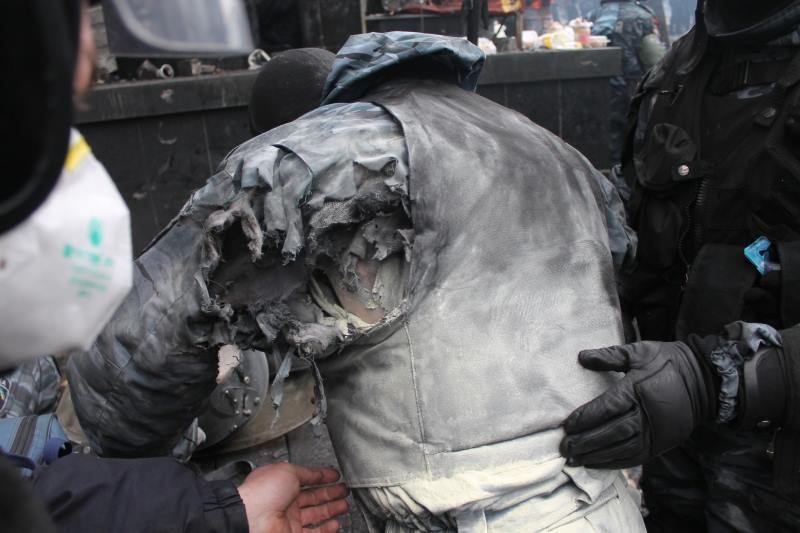
Policeman hit by a firework © Olga Sukharevskaya, 2013
Who started the war and the repressions?
Officially, the war in the Donbass began on April 13, 2014, when Turchinov announced the launch of an “antiterrorist operation,” following the Donetsk People’s Republic’s declaration of independence on April 7. The Lugansk People’s Republic declared independence on April 27, by which time Kiev’s operation was already underway.
In fact, Ukrainian forces were deployed to the Donbass in March 2014, long before these regions declared their independence. It’s true that the locals, protesting against the Euromaidan movement coming to power, started seizing government buildings. However, it was the Maidan activists who had used this tactic first, back in January 2014.
Meanwhile, people living in the pro-Russian southeastern regions of Ukraine simply organized protests at the weekend, hoping the new government would listen to them. Unlike their opponents, the 30 protesters who were burned alive in the Trade Unions Building in Odessa were not armed. It all came to light in ‘The Masks of the Revolution’ – a French documentary by Canal+ that the Ukrainian Embassy demanded be banned in Europe.
On May 9, 2014, Ukrainian tanks entered Mariupol city center, where unarmed people were marching in celebration of Victory Day in the Great Patriotic War. Later that day, there was a shootout in front of a local police station that involved the far-right Azov Battalion and resulted in casualties among policemen and civilians.
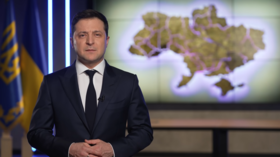
Read more
Even though the UN Office of the High Commissioner for Human Rights called for investigations, none have been conducted. On top of that, the repressions machine kicked into high gear, making prison sentences for anti-Euromaidan comments or likes on social media commonplace. A recent example is what happened to a Sumy Region local, who was convicted under Article 109 of the Criminal Code of Ukraine for once liking a post on the Odnoklassniky (Classmates) social network that spoke of unity between Russians, Ukrainians, and Belarusians. A couple of days ago, Deputy Head of National Police Alexander Fatsevich said “‘Russian world’ enthusiasts will be detained and brought to justice.” And, recently, the SBU charged prominent journalist Miroslava Berdnik, who recently had serious back surgery, with undermining Ukraine’s territorial integrity. The daughter of the Ukraine Helsinki Group co-founder Oles Berdnik, she is a human rights activist staunchly following in her father’s footsteps. Miroslava Berdnik even addressed the Israeli Knesset, outlining the issues of Nazism and anti-Semitism in Ukraine.
The Kiev government is ignoring the concerns of international organizations and preventing Russian artists from performing in Ukraine, as well as banning Russian books and Russian and even Ukrainian TV channels. The forced Ukrainization continues despite all resolutions passed by the Parliamentary Assembly of the Council of Europe. Matilda Bogner, head of the UN Human Rights Monitoring Mission in Ukraine, has pointed out incidents involving online bullying, threats, intimidation, and incitement to violence against those who are against Ukrainization or “who expressed positive views about the Russian language or otherwise expressed opinions perceived as pro-Russian.”
The infamous Myrotvorets (Peacekeeper) website that has collated the personal data of thousands of people, including EU and US nationals, remains operational. Recently, it added the President of Croatia Zoran Milanović and former head of the German navy Vice Admiral Kai-Achim Schönbach to its blacklist. But while high-profile figures in the Myrotvorets database have the means to ensure their own safety, people such as journalist Oles Buzina and head of the Joint Military Union of Ukraine Oleg Kalashnikov ended up dead.
Justification and spread of Nazism
Due to the active participation in the Euromaidan protests of radical far-right ultra-nationalists, who inherited the Organization of Ukrainian Nationalists’ (OUN) ideology dating back to World War II, today’s Ukraine condones support for Nazism. Despite the fact that the OUN was condemned by the European Parliament in its resolution of 25 February 2010 on the situation in Ukraine, in 2015, Kiev adopted a law ‘On the legal status and honoring of the memory of the fighters for the independence of Ukraine in the 20th century’. This law elevated the OUN and the Ukrainian Insurgent Army (UPA), who were abettors of the Third Reich, to the status of fighters for Ukraine’s independence. Among the leaders of these organizations were Stepan Bandera, recruited by Nazi Germany’s military intelligence agency, Abwehr, for espionage, and Roman Shukhevych, a hauptmann of the German Shutzmannschaft 201 auxiliary police battalion and one of the commanders of the Nachtigall Battalion.
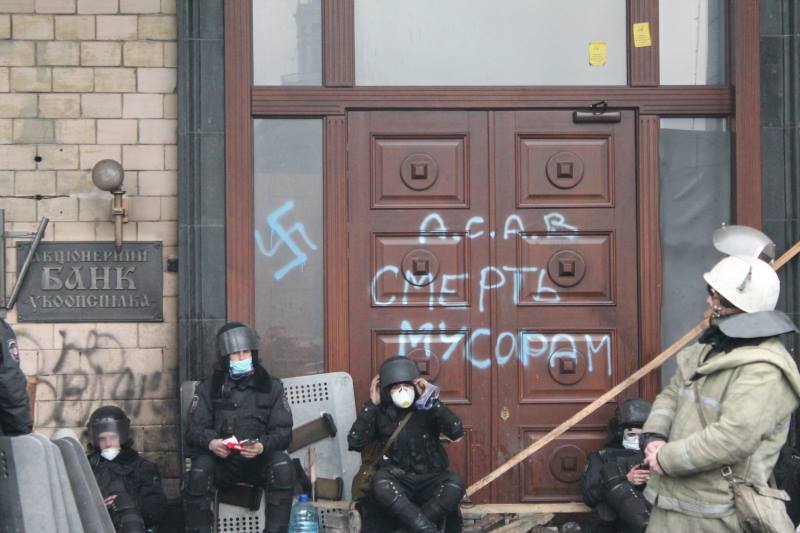
Nazi symbols drawn by Euromaidan activists, graffity says «Death to police» © Olga Sukharevskaya, 2013
The Act of Restoration of the Ukrainian State, announced by the OUN on 30 June 1941, is considered an important date in today’s Ukraine. Article 3 of this act reads as follows, “The newly formed Ukrainian state will work closely with the National-Socialist Greater Germany, under the leadership of its leader, Adolf Hitler, which is forming a new order in Europe and the world and is helping the Ukrainian people to free itself from Muscovite occupation.”
Addressing the UN Security Council, Elena Berezhnaya, head of the Irina Berezhnaya Institute for Legal Policy and Social Protection, said that glorification of the SS Galicia Division has become common practice in Ukraine, as has the erection of monuments to commemorate Bandera and his supporters, and government funding of neo-Nazi groups under the guise of patriotic education of the youth.
Today’s neo-OUN has deeply infiltrated both Ukraine’s government and law enforcement structures. The George Washington Institute of Public Policy has published a report saying that the Hetman Petro Sahaidachny National Army Academy, Ukraine’s premier military training institution, which is supported by the US administration, has been home to the far-right group Centuria.
And the activities of Ukrainian nationalists are not limited to Ukraine’s territory – they are actively promoting Nazi ideas in Western countries too. According to US outlet Politico, the Azov Battalion – which is controlled by an ex-member of the Ukrainian Parliament, Andriy Biletsky – has established a link with the Nordic Resistance Movement, a neo-Nazi group with official chapters operating in Sweden, Finland, and Norway. One of the Rise Above Movement’s founders, American white supremacist Robert Rundo was among those invited to attend a meeting with members of the battalion. The same article states that there is a connection between the same militia and Brenton Tarrant, an Australian white supremacist who killed 51 Muslims in an attack on a mosque in Christchurch, New Zealand. It also reports that US Army veteran Craig Lang, who is wanted for the 2018 slaying of a Florida couple, had been active on the front line in eastern Ukraine, where he had fought on Kiev’s side.
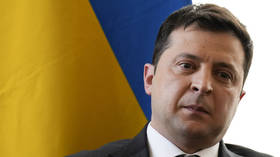
Read more
As outlined in a new report published by the US-based Soufan Center, which focuses on global security challenges and foreign policy issues, “Ukraine has emerged as a hub in the broader network of transnational white supremacy extremism, attracting foreign fighters from all over the world. Where jihadis travel to fight in places like Syria, white supremacists now have their own theater in which to learn combat – Ukraine, where the conflict between pro-Russian separatists and Ukrainian government forces has been raging since 2014, attracting fighters from around the globe who are fighting on both sides. Recent research shows that around 17,000 foreigners from 50 countries, including the United States, have gone to fight in that conflict.”
However, the demand voiced by the US Congress that the Azov Battalion – which was incorporated into Ukraine’s National Guard in November 2014 – be officially placed on the US’ list of foreign terrorist organizations has not been met, and neither has the ban imposed on funding it and other Ukrainian neo-Nazi militia been implemented.
Economic failure amid militarization
Ukraine’s military spending is now more than eight times higher than it was back in 2013, but the economy on the whole is in a deepening recession. In 2021, Ukrainian GDP stood at a record $195 billion (compared to $182 billion in 2013), but that was negated by inflation. When it came to certain goods, consumer inflation reached 11%, hitting a record high in the past three and a half years. The CEO of the CASE Ukraine think tank, Dmitry Boyarchuk, points out that, “in a number of areas, this growth is in name only: the prices on our exports were simply higher than the prices on our imports. But in terms of volume, our exports have been shrinking. We produce exactly as much as before, if not less, but we earned more because of the prices in the global markets.”
At the same time, the debt has been growing. In 2013, Ukraine’s external debt amounted to $27.9 billion, but by the end of 2021, it had reached $47.7 billion.
Ukraine has been gradually transforming from an industrial and agrarian country into a raw-materials supplier. In 2013, machine-building exports accounted for 18.9% ($12.9 billion), while, in 2017, they were down to 9.9% ($4.3 billion). The foreign trade structure for 2021 confirms this trend. Ukraine’s top exports last year were ferrous metals ($13.95 billion, up 81.4% compared to 2020), grains ($12.34 billion; +31.2%), and animal and vegetable fats and oils ($7.04 billion; + 22.5%). As for the imports, apart from energy resources, Kiev needs machines and equipment ($14.2 billion; +22.9%), as well as products of the chemical and related industries ($9.74 billion; +32.8%). It is ironic that the US ambassador said Ukraine must become an agrarian superpower. The “granary of the USSR,” as Ukraine was once known, is now importing more and more food. In 2021, it imported $8 billion worth of food products (+19% compared to 2020).

A destroyed armored vehicle in Kiev © Olga Sukharevskaya, 2013
At the same time, we’re seeing deindustrialization. In 2014, the Lvov Bus Factory was closed, and, in 2018, bankruptcy proceedings were initiated over the Zaporozhskiy Automobile Building Plant. In 2016-2019, the Antonov aircraft manufacturer didn’t produce a single plane. In July 2021, the Nikolayev Shipyard – once a key part of the Soviet shipbuilding industry – was officially closed. Yuzhmash, a large aerospace and rocket factory, has been barely staying afloat since 2014. In 2013, 50,449 cars were manufactured in Ukraine, but, by 2021, the number had decreased to 7002.
Living standards are also falling. Utilities rates keep rising, and, as of now, the utilities debt has reached $3 billion, owing to International Monetary Fund (IMF) requirements. Ukrainian political analyst Vladimir Chemeris explains that “the tariffs will keep rising. Back in summer 2020, our government signed a memorandum with the IMF, agreeing that gas prices should be fully market-determined. Market price means higher price. The IMF also underlined this requirement time and time again, and our government agreed, hoping for more and more loans to at least pay off the previous ones.”
Having terminated its gas supply contracts with Russia, Ukraine has had to deal with an energy crisis. On top of that, Kiev has to pay more for gas than even the EU countries. In October, gas prices across the EU ranged from €300 to €700, while, in Ukraine, it reached €1,100.
And so Ukrainians are leaving the country en masse. In 2020, 601,200 received EU residence permits. According to the Ptoukha Institute of Demography and Social Studies, in 2021, the number of migrant workers stood at 2.5 to 3 million people, while 1,068,000 Ukrainians obtained Russian citizenship in 2014-2021. In the first 10 months of 2021, the population outflow exceeded 600,000 – a record high in the past 11 years.
A survey carried out by the Kiev International Institute of Sociology shows that 64.7% of Ukrainian citizens believe things are going in the wrong direction. One in four Ukrainians and one in three young people want to move to a different country. All in all, this can hardly be called a victory for the Euromaidan.
By Olga Sukharevskaya, a Ukrainian-born ex-diplomat, legist, and author based in Moscow



